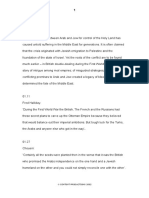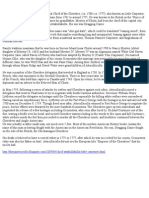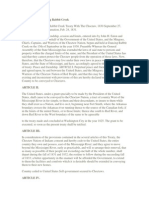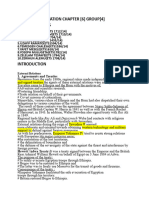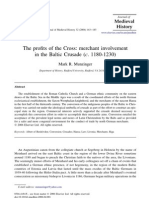Trail of Tears
Trail of Tears
Uploaded by
willbfreeCopyright:
Available Formats
Trail of Tears
Trail of Tears
Uploaded by
willbfreeCopyright
Available Formats
Share this document
Did you find this document useful?
Is this content inappropriate?
Copyright:
Available Formats
Trail of Tears
Trail of Tears
Uploaded by
willbfreeCopyright:
Available Formats
Trail of Tears
From Wikipedia, the free encyclopedia
The Trail of Tears, was painted by Robert Lindneux in 1942. It commemorates the suffering of the Cherokee people under forced removal. The painting erroneously portrays the Cherokees as possessing warm blankets, wagons, and horses. In reality, Native Americans were often allowed to carry little more than the clothes on their backs. The Trail of Tears was the relocation and movement of Native Americans in the United States from their homelands to Indian Territory (present day Oklahoma) in the Western United States. The phrase originated from a description of the removal of the Choctaw Nation in 1831.[1] Many Native Americans suffered from exposure, disease, and starvation while en route to their destinations, and many died, including 4,000 of the 15,000 relocated Cherokee.[2] In 1831, the Cherokee, Chickasaw, Choctaw, Muscogee-Creek, and Seminole (sometimes collectively referred to as the Five Civilized Tribes) were living as autonomous nations in what would be called the American Deep South. The process of cultural transformation (proposed by George Washington and Henry Knox) was gaining momentum, especially among the Cherokee and Choctaw.[3] Andrew Jackson was the first U.S. President to implement removal of the Native Americans with the passage of the Indian Removal Act of 1830. In 1831 the Choctaw were the first to be removed, and they became the model for all other removals. After the Choctaw, the Seminole were removed in 1832, the Creek in 1834, then the Chickasaw in 1837, and finally the Cherokee in 1838.[citation needed] After removal Native Americans remained in their ancient homelands - the Choctaw are found in Mississippi, the Seminole in Florida, the Creek in Alabama, and the Cherokee in North Carolina. Europeans and Africans (usually as slaves) also accompanied the Native American nations on the trek westward.[citation needed] By 1837, 46,000 Native Americans
from these southeastern nations had been removed from their homelands thereby opening 25 million acres for settlement by Americans.[4]
Contents
[hide]
1 Choctaw voluntary removal 2 Seminole resistance 3 Creek dissolution 4 Chickasaw monetary removal 5 Cherokee forced relocation 6 See also 7 Notes 8 References 9 Documents 10 Documentary 11 External links
Choctaw voluntary removal
Main article: Choctaw Trail of Tears
In 1832 a young twenty-two year old Harkins wrote the Farewell Letter to the American People. The Choctaw nation was in what are now the U.S. states of Alabama, Mississippi, and Louisiana. After a series of treaties starting in 1801, the Choctaw nation was reduced to 11,000,000 acres (45,000 km2). The Treaty of Dancing Rabbit Creek ceded the remaining country to the United States and was ratified in early 1831. The removals were only agreed to after a provision in the Treaty of Dancing Rabbit Creek allowed some Choctaw
to remain. George W. Harkins would write to the American people before the removals were to commence.
It is with considerable diffidence that I attempt to address the American people, knowing and feeling sensibly my incompetency; and believing that your highly and well improved minds would not be well entertained by the address of a Choctaw. But having determined to emigrate west of the Mississippi river this fall, I have thought proper in bidding you farewell to make a few remarks expressive of my views, and the feelings that actuate me on the subject of our removal ... We as Choctaws rather chose to suffer and be free, than live under the degrading influence of laws, which our voice could not be heard in their formation. .
-George W. Harkins, George W. Harkins to the American People[5]
Secretary of War Lewis Cass appointed George Gaines to manage the removals. Gaines decided to remove Choctaws in three phases starting in 1831 and ending in 1833. The first was to begin on November 1, 1831 with groups meeting at Memphis and Vicksburg. A harsh winter would batter the emigrants with flash floods, sleet, and snow. Initially the Choctaws were to be transported by wagon but floods halted them. With food running out, the residents of Vicksburg and Memphis were concerned. Five steamboats (the Walter Scott, the Brandywine, the Reindeer, the Talma, and the Cleopatra) would ferry Choctaws to their river-based destinations. The Memphis group traveled up the Arkansas for about 60 miles (97 km) to Arkansas Post. There the temperature stayed below freezing for almost a week with the rivers clogged with ice, so there would be no travel for weeks. Food rationing consisted of a handful of boiled corn, one turnip, and two cups of heated water per day. Forty government wagons were sent to Arkansas Post to transport them to Little Rock. When they reached Little Rock, Choctaw chief (thought to be Thomas Harkins or Nitikechi) quoted to the Arkansas Gazette that the removal was a "trail of tears and death."[6] The Vicksburg group was led by an incompetent guide and was lost in the Lake Providence swamps.
Alexis de Tocqueville, French political thinker and historian. Alexis de Tocqueville, the French philosopher, witnessed the Choctaw removals while in Memphis, Tennessee in 1831,
In the whole scene there was an air of ruin and destruction, something which betrayed a final and irrevocable adieu; one couldn't watch without feeling one's heart wrung. The Indians were tranquil, but sombre and taciturn. There was one who could speak English and of whom I asked why the Chactas were leaving their country. "To be free," he answered, could never get any other reason out of him. We ... watch the expulsion ... of one of the most celebrated and ancient American peoples.
- Alexis de Tocqueville, Democracy in America[7]
Nearly 17,000 Choctaws made the move to what would be called Indian Territory and then later Oklahoma.[8] About 2,5006,000 died along the trail of tears. Approximately 5,0006,000 Choctaws remained in Mississippi in 1831 after the initial removal efforts.[9] [10] The Choctaws who chose to remain in newly formed Mississippi were subject to legal conflict, harassment, and intimidation. The Choctaws "have had our habitations torn down and burned, our fences destroyed, cattle turned into our fields and we ourselves have been scourged, manacled, fettered and otherwise personally abused, until by such treatment some of our best men have died."[10] The Choctaws in Mississippi were later be formed as the Mississippi Band of Choctaw Indians and the removed Choctaws be called the Choctaw Nation of Oklahoma.
Seminole resistance
Main article: Seminole Wars
Seminole warrior Tuko-see-mathla, 1834. The US acquired Florida from Spain via the Adams-Ons Treaty and took possession in 1821. In 1832 the Seminoles were called to a meeting at Payne's Landing on the Ocklawaha River. The treaty negotiated called for the Seminoles to move west, if the land were found to be suitable. They were to be settled on the Creek reservation and become part of the Creek tribe. The Seminole Indians who originated from the Creek were considered deserters by the Creek, and the Seminole did not wish to move west to where they were certain that they would meet death for leaving the main band Creek Indians. The delegation of seven chiefs who were to inspect the new reservation did not leave Florida until October 1832. After touring the area for several months and conferring with the Creeks who had already been settled there, the seven chiefs signed on March 28, 1833 a statement that the new land was acceptable. Upon their return to Florida, however, most of the chiefs renounced the statement, claiming that they had not signed it, or that they had been forced to sign it, and in any case, that they did not have the power to decide for all the tribes and bands that resided on the reservation. The villages in the area of the Apalachicola River were more easily persuaded, however, and went west in 1834. [11] On December 28, 1835 a group of Seminoles and escaped slaves ambushed a U.S. Army company attempting to forcibly remove the Seminole. Out of 110 army troops only 3 survived, and with that the Second Seminole War had begun. As the realization that the Seminoles would resist relocation sank in, Florida began preparing for war. The St. Augustine Militia asked the War Department for the loan of 500 muskets. Five hundred volunteers were mobilized under Brig. Gen. Richard K. Call. Indian war parties raided farms and settlements, and families fled to forts, large towns, or out of the territory altogether. A war party led by Osceola captured a Florida militia supply train, killing eight of its guards and wounding six others. Most of the goods taken were recovered by the militia in another fight a few days later. Sugar plantations along the Atlantic coast south of St. Augustine were destroyed, with many of the slaves on the plantations joining the Seminoles.[12]
Other warchiefs such as Halleck Tustenuggee, Jumper, and Black Seminoles Abraham and John Horse continued the Seminole resistance against the army. The war ended, after a full decade of fighting, in 1842. The U.S. government is estimated to have spent about $20,000,000 on the war, at the time an astronomical sum. Many Indians were forcibly exiled to Creek lands west of the Mississippi; others retreated into the Everglades. In the end, the government gave up trying to subjugate the Seminole in their Everglades redoubts and left fewer than 100 Seminoles in peace.[13]
Creek dissolution
Main article: Creek (American Indians) After the War of 1812, some Muscogee leaders such as William McIntosh signed treaties that ceded more land to Georgia. The 1814 signing of the Treaty of Fort Jackson signaled the end for the Creek Nation and for all Indians in the South.[14] Friendly Creek leaders, like Selocta and Big Warrior, addressed Sharp Knife (the Indian nickname for Andrew Jackson) and reminded him that they keep the peace. Nevertheless, Jackson retorted that they did not "cut (Tecumseh's) throat" when they had the chance, so they must now cede Creek lands. Jackson also ignored Article 9 of the Treaty of Ghent that restored sovereignty to Indians and their nations.
Jackson opened this first peace session by faintly acknowledging the help of the friendly Creeks. That done, he turned to the Red Sticks and admonished them for listening to evil counsel. For their crime, he said, the entire Creek Nation must pay. He demanded the equivalent of all expenses incurred by the United States in prosecuting the war, which by his calculation came to 23,000,000 acres (93,000 km2) of land.
- Robert V. Remini, Andrew Jackson[15]
Selocta (or Shelocta) was a Muscogee chief who appealed to Andrew Jackson to reduce the demands for Creek lands at the signing of the Treaty of Fort Jackson.[16] Eventually, the Creek Confederacy enacted a law that made further land cessions a capital offense. Nevertheless, on February 12, 1825, McIntosh and other chiefs signed the Treaty of Indian Springs, which gave up most of the remaining Creek lands in Georgia.[17] After the U.S. Senate ratified the treaty, McIntosh was assassinated on May 13, 1825, by Creeks led by Menawa. The Creek National Council, led by Opothle Yohola, protested to the United States that the Treaty of Indian Springs was fraudulent. President John Quincy Adams was sympathetic, and eventually the treaty was nullified in a new agreement, the Treaty of Washington (1826).[18] Writes historian R. Douglas Hurt: "The Creeks had accomplished what no Indian nation had ever done or would do again achieve the annulment of a ratified treaty."[19] However, Governor Troup of Georgia ignored the new treaty and began to forcibly remove the Indians under the terms of the earlier treaty. At first, President Adams attempted to intervene with federal troops, but Troup called out the militia, and Adams, fearful of a civil war, conceded. As he explained to his intimates, "The Indians are not worth going to war over." Although the Creeks had been forced from Georgia, with many Lower Creeks moving to the Indian Territory, there were still about 20,000 Upper Creeks living in Alabama. However, the state moved to abolish tribal governments and extend state laws over the Creeks. Opothle Yohola appealed to the administration of President Andrew Jackson for protection from Alabama; when none was forthcoming, the Treaty of Cusseta was signed on March 24, 1832, which divided up Creek lands into individual allotments.[20] Creeks could either sell their allotments and received funds to remove to the west, or stay in Alabama and submit to state laws. Land speculators and squatters began to defraud Creeks out of their allotments, and violence broke out, leading to the so-called "Creek War of 1836." Secretary of War Lewis Cass dispatched General Winfield Scott to end the violence by forcibly removing the Creeks to the Indian Territory west of the Mississippi River.
Chickasaw monetary removal
Main article: Chickasaw Unlike other tribes who exchanged land grants, the Chickasaw received financial compensation from the United States for their lands east of the Mississippi River. In 1836 the Chickasaws had reached an agreement that purchased land from the previously removed Choctaws after a bitter five-year debate. They paid the Choctaws $530,000 for the western most part Choctaw land. The first group of Chickasaws moved in 1837 was led by John M. Millard. The Chickasaws gathered at Memphis, Tennessee on July 4, 1837, with all of their assets--belongings, livestock, and slaves. Once across the Mississippi River they followed routes previously established by Choctaws and Creeks.
Once in Indian Territory the Chickasaws merged with the Choctaw nation. After several decades of mistrust, they regained nationhood.
Cherokee forced relocation
Main article: Cherokee trail of tears
Principal Cherokee Chief John Ross. Image capture in the late 1800s. In 1838, the Cherokee Nation was removed from their lands in the Southeastern United States to the Indian Territory (present day Oklahoma) in the Western United States, which resulted in the deaths of approximately 4,000 Cherokees.[21] In the Cherokee language, the event is called Nunna daul Isunyithe Trail Where They Cried. The Cherokee Trail of Tears resulted from the enforcement of the Treaty of New Echota, an agreement signed under the provisions of the Indian Removal Act of 1830 which exchanged Native American land in the East for lands west of the Mississippi River, but which was never accepted by the elected tribal leadership or a majority of the Cherokee people. Tensions between Georgia and the Cherokee Nation were brought to a crisis by the discovery of gold near Dahlonega, Georgia, in 1829, resulting in the Georgia Gold Rush, the first gold rush in U.S. history. Hopeful gold speculators began trespassing on Cherokee lands, and pressure began to mount on the Georgia government to fulfill the promises of the Compact of 1802. When Georgia moved to extend state laws over Cherokee tribal lands in 1830, the matter went to the U.S. Supreme Court. In Cherokee Nation v. Georgia (1831), the Marshall court ruled that the Cherokees were not a sovereign and independent nation, and therefore refused to hear the case. However, in Worcester v. State of Georgia (1832), the Court ruled that Georgia could not impose laws in Cherokee territory, since only the national government not state governments had authority in Indian affairs.
John Marshall has made his decision; now let him enforce it! ... Build a fire under them. When it gets hot enough, they'll go.
-Andrew Jackson, 1832, The Trail of Tears Across Missouri.[22]
Jackson probably never said this, but he was fully committed to the policy. He had no desire to use the power of the national government to protect the Cherokees from Georgia, since he was already entangled with states rights issues in what became known as the nullification crisis. With the Indian Removal Act of 1830, the U.S. Congress had given Jackson authority to negotiate removal treaties, exchanging Indian land in the East for land west of the Mississippi River. Jackson used the dispute with Georgia to put pressure on the Cherokees to sign a removal treaty.[23]
Portrait of Marcia Pascal, a young Cherokee woman. Image captured in the late 1800s. Nevertheless, the treaty, passed by Congress by a single vote, and signed into law by President Andrew Jackson, was imposed by his successor President Martin Van Buren who allowed Georgia, Tennessee, North Carolina, and Alabama an armed force of 7,000 made up of militia, regular army, and volunteers under General Winfield Scott to round up about 13,000 Cherokees into concentration camps at the U.S. Indian Agency near Cleveland, Tennessee before being sent to the West. Most of the deaths occurred from disease, starvation and cold in these camps. Their homes were burned and their property destroyed and plundered. Farms belonging to the Cherokees for generations were won by white settlers in a lottery. After the initial roundup, the U.S. military still oversaw the emigration until they met the forced destination.[24] Private John G. Burnett later wrote "Future generations will read and condemn the act and I do hope posterity will remember that private soldiers like myself, and like the four Cherokees who were forced by General Scott to shoot an Indian Chief and his children, had to execute the orders of our superiors. We had no choice in the matter."[25]
I fought through the War Between the States and have seen many men shot, but the Cherokee Removal was the cruelest work I ever knew.
- Georgia soldier who participated in the removal,[26]
In the winter of 1838 the Cheroke began the thousand mile march with scant clothing and most on foot without shoes or moccasins. The march began in Red Clay, Tennessee, the location of the last Eastern capital of the Cherokee Nation. The Cherokee were given used blankets from a hospital in Tennessee where an epidemic of small pox had broken out. Because of the diseases, the Indians were not allowed to go into any towns or villages along the way; many times this meant traveling much farther to go around them. [27] After crossing Tennessee and Kentucky, they arrived in Southern Illinois at Golconda about the 3rd of December, 1838. Here the starving Indians were charged a dollar a head to cross the river on "Berry's Ferry" which typically charged twelve cents. They were not allowed passage until the ferry had serviced all others wishing to cross and were forced to take shelter under "Mantle Rock," a shelter bluff on the Kentucky side, until "Berry had nothing better to do". Many died huddled together at Mantle Rock waiting to cross. Several Cherokee were murdered by locals. The killers filed a lawsuit against the U.S. Government through the courthouse in Vienna, suing the government for $35 a head to bury the murdered Cherokee.[28] On December 26, Martin Davis, Commissary Agent for Moses Daniel's detachment wrote: "There is the coldest weather in Illinois I ever experienced anywhere. The streams are all frozen over something like eight or twelve inches thick. We are compelled to cut through the ice to get water for ourselves and animals. It snows here every two or three days at the fartherest. We are now camped in Missippi swamp four miles from the river, and there is no possible chance of crossing the river for the numerous quantity of ice that comes floating down the river every day. We have only traveled sixty-five miles on the last month, including the time spent at this place, which has been about three weeks. It is unknown when we shall cross the river...."[29]
Lillian Gross, a young multiracial Cherokee. Image capture in 1906. Removed Cherokees initially settled near Tahlequah, Oklahoma. The political turmoil resulting from the Treaty of New Echota and the Trail of Tears led to the assassinations of Major Ridge, John Ridge, and Elias Boudinot; of the leaders of the Treaty Party, only Stand Watie escaped his assassins. The population of the Cherokee Nation eventually rebounded, and today the Cherokees are the largest American Indian group in the United States.[30] There were some exceptions to removal. Perhaps 100 Cherokees evaded the U.S. soldiers and lived off the land in Georgia and other states. Those Cherokees who lived on private, individually owned lands (rather than communally owned tribal land) were not subject to removal. In North Carolina, about 400 Cherokees, known as the Oconaluftee Cherokee, lived on land in the Great Smoky Mountains owned by a white man named William Holland Thomas (who had been adopted by Cherokees as a boy), and were thus not subject to removal. Added to this were some 200 Cherokee from the Nantahala area allowed to stay after assisting the U.S. Army hunt down and capture the family of the old prophet Tsali (Tsali faced a firing squad). These North Carolina Cherokees became the Eastern Band of the Cherokee Nation. The rare and sought after "Trail of tears" variety of bean is very productive and was grown by the Cherokee before the resettlement. The Cherokee were able to preserve this heirloom variety of bean during the upheaval.
See also
Cherokee Cherokee Trail of Tears Chickasaw Choctaw Creek people Ethnic cleansing, the modern term for the forced relocation of a people Population transfer Indian Removal Hopkinsville, Kentucky Seminole Timeline of Cherokee removal
Notes
1. ^ Len Green. "Choctaw Removal was really a "Trail of Tears"". Bishinik, mboucher, University of Minnesota. http://www.tc.umn.edu/~mboucher/mikebouchweb/choctaw/trtears.htm. Retrieved 2008-04-28.
2. ^ Nancy C., Curtis. Black Heritage Sites. United States: ALA Editions. p. 543. ISBN 0838906435. http://books.google.com/books?id=Rk7NPRm_nB0C. 3. ^ Perdue, Theda. "Chapter 2 'Both White and Red'". Mixed Blood Indians: Racial Construction in the Early South. The University of Georgia Press. p. 51. ISBN 082032731X. 4. ^ Indian removals 1814 - 1858. 5. ^ Harkins, George (1831). "1831 - December - George W. Harkins to the American People". http://anpa.ualr.edu/trailOfTears/letters/1831DecemberGeorgeWHarkinstotheAm ericanPeople.htm. Retrieved 2008-04-23. 6. ^ Chris Watson. "The Choctaw Trail of Tears". http://www.thebicyclingguitarist.net/studies/trailoftears.htm. Retrieved 2008-0429. 7. ^ de Tocqueville, Alexis (1835-1840). "Tocqueville and Beaumont on Race". http://xroads.virginia.edu/~HYPER/DETOC/race/indian.html. Retrieved 2008-0428. 8. ^ Satz, Ronald. "The Mississippi Choctaw: From the Removal Treaty of the Federal Agency". in Samuel J. Wells and Roseanna Tuby. After Removal: The Choctaw in Mississippi. University Press of Mississippi. p. 7. ISBN 0878052895. 9. ^ Baird, David. "The Choctaws Meet the Americans, 1783 to 1843". The Choctaw People. United States: Indian Tribal Series. p. 36. Library of Congress 73-80708. 10. ^ a b Walter, Williams. "Three Efforts at Development among the Choctaws of Mississippi". Southeastern Indians: Since the Removal Era. Athens, Georgia: University of Georgia Press. 11. ^ Missall. pp. 83-85. 12. ^ Missall. pp. 93-94. 13. ^ Covington, James W. 1993. The Seminoles of Florida. Gainesville, Florida: University Press of Florida. ISBN 0-8130-1196-5. pp. 145-6. 14. ^ Remini, Robert. "The Creek War: Victory". Andrew Jackson. History Book Club. p. 231. ISBN 0965063106. 15. ^ Remini, Robert. "The Creek War: Victory". Andrew Jackson. History Book Club. p. 226. ISBN 0965063106. 16. ^ Remini, Robert. "The Creek War: Victory". Andrew Jackson. History Book Club. p. 228. ISBN 0965063106. 17. ^ Oklahoma State University Library. "INDIAN AFFAIRS: LAWS AND TREATIES. Vol. 2, Treaties". Digital.library.okstate.edu. http://digital.library.okstate.edu/kappler/Vol2/treaties/cre0214.htm. Retrieved 2009-01-25. 18. ^ INDIAN AFFAIRS: LAWS AND TREATIES. 19. ^ Hurt, R. Douglas (2002). The Indian Frontier, 1763-1846 (Histories of the American Frontier). Albuquerque: University of New Mexico Press. p. 148. ISBN 0826319661. 20. ^ Oklahoma State University Library. "INDIAN AFFAIRS: LAWS AND TREATIES. Vol. 2, Treaties". Digital.library.okstate.edu.
http://digital.library.okstate.edu/kappler/Vol2/treaties/cre0341.htm. Retrieved 2009-01-25. 21. ^ Cherokee Nation of Oklahoma: http://www.cherokee.org/Culture/CulInfo/TOT/58/Default.aspx 22. ^ Gilbert, Joan. "The Cherokee Home in the East". The Trail of Tears Across Missouri. University of Missouri Press. p. 14. ISBN 0826210635. 23. ^ Remini, Andrew Jackson, p. 257, Prucha, Great Father, p. 212. 24. ^ Myths of the Cherokee and Sacred Formulas of the Cherokees By James Mooney, p. 130. 25. ^ "Birthday Story of Private John G. Burnett, Captain Abraham McClellans Company, 2nd Regiment, 2nd Brigade, Mounted Infantry, Cherokee Indian Removal, 1838-39", Cherokee Nation official site, http://www.cherokee.org/Culture/CulInfo/TOT/128/Default.aspx 26. ^ Remini, Robert. "Invasion". The Earth Shall Weep: A History of Native America. Grove Press. p. 170. ISBN 080213680X. 27. ^ Illinois General Assembly - HJR0142. 28. ^ Illinois General Assembly - HJR0142. 29. ^ Adams, Mattie Lorraine. Family Tree of Daniel and Rachel Davis. Duluth, Georgia: Claxton Printing Company, 1973. 30. ^ "Top 25 American Indian Tribes for the United States: 1990 and 1980". U.S. Bureau of the Census. August 1995. http://www.census.gov/population/socdemo/race/indian/ailang1.txt.
References
Wikisource has original text related to this article: Appeal of the Cherokee Nation
Anderson, William L., ed. Cherokee Removal: Before and After. Athens, Georgia: University of Georgia Press, 1991. Carter, Samuel. Cherokee Sunset: A Nation Betrayed. New York: Doubleday, 1976. ISBN 0-385-06735-6. Ehle, John. Trail of Tears: The Rise and Fall of the Cherokee Nation. New York: Doubleday, 1988. ISBN 0-385-23953-X. Fitzgerald, David G. and King, Duane E., The Cherokee Trail of Tears, Grsaphic Arts Books,Portland, OR, 2005. Foreman, Grant. Indian Removal: The Emigration of the Five Civilized Tribes of Indians. Norman, Oklahoma: University of Oklahoma Press, 1932, 11th printing 1989. ISBN 0-8061-1172-0. Prucha, Francis Paul. The Great Father: The United States Government and the American Indians. Volume I. Lincoln, Nebraska: University of Nebraska Press, 1984. ISBN 0-8032-3668-9. Remini, Robert V. Andrew Jackson and his Indian Wars. New York: Viking, 2001. ISBN 0-670-91025-2.
Wallace, Anthony F.C. The Long, Bitter Trail: Andrew Jackson and the Indians. New York: Hill and Wang, 1993. ISBN 0-8090-1552-8 (paperback); ISBN 08090-6631-9 (hardback).
Documents
Cherokee Indian Removal Debate U.S. Senate, April 15-17, 1830 Winfield Scott's Address to the Cherokee Nation, May 10, 1838 Gen. Winfield Scott's Order to U.S. Troops
Documentary
The Trail of Tears: Cherokee Legacy (2006) -directed by Chip Richie; na by James Earl Jones
External links
Remote Sensing Technology to Understanding the Choctaw Removals Trail of Tears National Historic Trail (U.S. National Park Service) The North Little Rock Site: Interpretive Contexts Chickasaw Seminole Tribe of Florida History: Indian Resistance and Removal Muscogee (Creek) Removal The Trail of Tears and the Forced Relocation of the Cherokee Nation, a National Park Service Teaching with Historic Places (TwHP) lesson plan Cherokee Heritage Documentation Center Cherokee Nation Cultural Resource Center Trail of Tears - The Dream We Dreamed Cherokee Indian Removal, Encyclopedia of Alabama
You might also like
- Native American ObituariesDocument522 pagesNative American ObituariesJim Heddell56% (9)
- The Cherokee Removal A Brief History With DocumentsDocument40 pagesThe Cherokee Removal A Brief History With DocumentsGabriel Owen43% (14)
- Articles of Confederation Simulation PacketDocument6 pagesArticles of Confederation Simulation Packetapi-31511068375% (4)
- Promises & Betrayals ScriptDocument37 pagesPromises & Betrayals ScriptSonja NjonjaNo ratings yet
- Agan Vs Piatco DigestDocument4 pagesAgan Vs Piatco DigestCheska Almira J. ArellanoNo ratings yet
- Historia de Inglaterra y EEUU Costa, Antonella Ribolta, JenniferDocument6 pagesHistoria de Inglaterra y EEUU Costa, Antonella Ribolta, Jenniferarcher70No ratings yet
- Trail of TearsDocument5 pagesTrail of Tearsapi-312881892100% (1)
- 820 Westward Expansion The Trail of TearsDocument6 pages820 Westward Expansion The Trail of TearsEmily Fern67% (3)
- Rolls (Including $5 Indians) Dawes - CherokeeDocument871 pagesRolls (Including $5 Indians) Dawes - Cherokeenujahm163971% (7)
- Who Is The Original ManDocument26 pagesWho Is The Original Manwillbfree85% (13)
- The Fruit of Islam and The Secret Relationship Between Blacks and Jews-2Document8 pagesThe Fruit of Islam and The Secret Relationship Between Blacks and Jews-2willbfree100% (3)
- The Cyprus QuestionDocument72 pagesThe Cyprus QuestionAlexy Flemming100% (1)
- Hamilcar BarcaDocument12 pagesHamilcar BarcaKelsey MullerNo ratings yet
- Cherokee & Trail of TearsDocument7 pagesCherokee & Trail of TearsRyan McKinneyNo ratings yet
- Trail of TearsDocument136 pagesTrail of Tearshenry100% (1)
- Native Americans Indian RemovalDocument17 pagesNative Americans Indian Removalapi-353426737100% (1)
- (Done) Indian Removal ActDocument5 pages(Done) Indian Removal ActFernando García FloresNo ratings yet
- Who Are The Western CherokeeDocument13 pagesWho Are The Western CherokeeWill Blueotter AndersonNo ratings yet
- Forced Removal: Causes and Effects of the Trail of TearsFrom EverandForced Removal: Causes and Effects of the Trail of TearsNo ratings yet
- Cherokee Freedman PresentationDocument14 pagesCherokee Freedman Presentationaqshawt100% (1)
- Chronology and Timeline For American Indian HistoryDocument9 pagesChronology and Timeline For American Indian Historybinahermana100% (1)
- Trail of Tears Primary Source John G. BurnettDocument3 pagesTrail of Tears Primary Source John G. BurnettOdis Running Wolf BullockNo ratings yet
- Index - History of The Cherokee Nation by Robert J. Conley1Document4 pagesIndex - History of The Cherokee Nation by Robert J. Conley1Joseph Brad DrowningBearNo ratings yet
- Chief AttacullacullaDocument1 pageChief Attacullacullaksmith_3434No ratings yet
- Treaty of Dancing Rabbit Creek - Pages 1 and 2Document2 pagesTreaty of Dancing Rabbit Creek - Pages 1 and 2nathanle98No ratings yet
- The Cherokee Nation of Indians: A Narrative of Their Official Relations With the Colonial and Federal GovernmentsFrom EverandThe Cherokee Nation of Indians: A Narrative of Their Official Relations With the Colonial and Federal GovernmentsNo ratings yet
- An American Betrayal Cherokee Patriots and The Trail of TearsDocument13 pagesAn American Betrayal Cherokee Patriots and The Trail of TearsMacmillan Publishers100% (1)
- Will Colacito CherokeeDocument23 pagesWill Colacito CherokeeWill Colacito0% (1)
- The Cherokee Nation or Tribe of Indians in Oklahoma, The Choctaw Nation and The Chickasaw Nation v. State of Oklahoma, 402 F.2d 739, 10th Cir. (1968)Document12 pagesThe Cherokee Nation or Tribe of Indians in Oklahoma, The Choctaw Nation and The Chickasaw Nation v. State of Oklahoma, 402 F.2d 739, 10th Cir. (1968)Scribd Government Docs100% (2)
- Old Hop - Chief KanagatoogaDocument2 pagesOld Hop - Chief Kanagatoogaksmith_3434100% (1)
- Hildebrand RouteDocument2 pagesHildebrand RouteMichael H ChristensenNo ratings yet
- Catawba Indian Genealogy 2004Document125 pagesCatawba Indian Genealogy 2004Aaza100% (1)
- End of The Native AmericansDocument33 pagesEnd of The Native AmericansWill TeeceNo ratings yet
- Remembering Cherokee RemovalDocument18 pagesRemembering Cherokee Removalritolab100% (1)
- Yuchi LanguageDocument3 pagesYuchi Languageheketiwa alukaNo ratings yet
- South Carolina v. Catawba Tribe, Inc., 476 U.S. 498 (1986)Document26 pagesSouth Carolina v. Catawba Tribe, Inc., 476 U.S. 498 (1986)Scribd Government DocsNo ratings yet
- Nancy Ward 1738Document4 pagesNancy Ward 1738ksmith_3434100% (1)
- Jane Davis, PHD Candidate, Middle Tennessee State UniversityDocument12 pagesJane Davis, PHD Candidate, Middle Tennessee State UniversityJane DavisNo ratings yet
- Creek IndiansDocument13 pagesCreek Indiansapi-301948456100% (2)
- Jackson Indian Removal WorksheetDocument6 pagesJackson Indian Removal WorksheetEmran Alam100% (1)
- The Croatan Indians of Sampson County, North Carolina: Their Origin and Racial StatusFrom EverandThe Croatan Indians of Sampson County, North Carolina: Their Origin and Racial StatusNo ratings yet
- Appalachian MigrationsDocument13 pagesAppalachian MigrationsRobert MaslowskiNo ratings yet
- Oklahoma: Astronauts, Tornadoes, and Indian Territory: Think You Know Your States?, #16From EverandOklahoma: Astronauts, Tornadoes, and Indian Territory: Think You Know Your States?, #16No ratings yet
- America: North America, Central America, South AmericaDocument25 pagesAmerica: North America, Central America, South AmericaRizwan Nadeem100% (1)
- History of South Carolina From Its First Settlement in 1670 To The Year 1808-V1-1858-David RamsayDocument294 pagesHistory of South Carolina From Its First Settlement in 1670 To The Year 1808-V1-1858-David Ramsayzepolk100% (3)
- Colonial Records of the State of Georgia: Volume 27: Original Papers of Governor John Reynolds, 1754-1756From EverandColonial Records of the State of Georgia: Volume 27: Original Papers of Governor John Reynolds, 1754-1756No ratings yet
- Indian TidbitsDocument3 pagesIndian Tidbitsksmith_3434No ratings yet
- Lesson 2 - Indian Removal and Manifest Destiny 1Document11 pagesLesson 2 - Indian Removal and Manifest Destiny 1api-309160992No ratings yet
- Totem Pole InformationDocument18 pagesTotem Pole InformationLorrin BundesenNo ratings yet
- Manifest DestinyDocument16 pagesManifest Destinyapi-367477549100% (2)
- Cherokee Nation v. Georgia 30 US 1 (1831) PDFDocument80 pagesCherokee Nation v. Georgia 30 US 1 (1831) PDFVSR AppsNo ratings yet
- MississippiansDocument20 pagesMississippiansapi-272760815No ratings yet
- Native American MythsDocument18 pagesNative American MythsThiago LeiteNo ratings yet
- Appendices and BibliographyDocument73 pagesAppendices and BibliographyPam WilsonNo ratings yet
- 8 The Civil War Chapter 11Document96 pages8 The Civil War Chapter 11Joshua HatchNo ratings yet
- Indian ProblemDocument7 pagesIndian ProblemAbhinava GoswamiNo ratings yet
- Reconstruction To Jim Crow AmericaDocument24 pagesReconstruction To Jim Crow Americaapi-3009380150% (2)
- California Through Native Eyes: Reclaiming HistoryDocument26 pagesCalifornia Through Native Eyes: Reclaiming HistoryUniversity of Washington PressNo ratings yet
- Guion Miller Roll IndexDocument2 pagesGuion Miller Roll Indexksmith_3434No ratings yet
- Exploration of America 1492-1600 Native American European ExploresDocument9 pagesExploration of America 1492-1600 Native American European ExploresДмитрий Портной100% (1)
- 1.1. Pre-Columbian History of Native Americans.: An Outline of American History, United States Information Agency, P 7Document6 pages1.1. Pre-Columbian History of Native Americans.: An Outline of American History, United States Information Agency, P 7bella19883757No ratings yet
- Native American SystemDocument20 pagesNative American Systemsmss_proe5945No ratings yet
- Native American HistoryDocument8 pagesNative American HistoryAndy Sovaga100% (1)
- The Siouan Indians by McGee, W. J. (William John), 1853-1912Document48 pagesThe Siouan Indians by McGee, W. J. (William John), 1853-1912Gutenberg.orgNo ratings yet
- Jewish InfluenceDocument38 pagesJewish InfluencewillbfreeNo ratings yet
- Sacred Health GeometryDocument9 pagesSacred Health GeometryLeigh Smith100% (1)
- Automobile Self InsuranceDocument20 pagesAutomobile Self Insurancewillbfree100% (7)
- METAL ADORNMENTS OF or WITH BALKAN INFLUENCESDocument16 pagesMETAL ADORNMENTS OF or WITH BALKAN INFLUENCESIoana Stoican DuicuNo ratings yet
- Introduction of Intellectual Property Rights in India Chapter 1 Part 2Document12 pagesIntroduction of Intellectual Property Rights in India Chapter 1 Part 2NishantNo ratings yet
- Foreign PolicyDocument6 pagesForeign PolicyAdnan QureshiNo ratings yet
- NJGM Memo 2014-014Document4 pagesNJGM Memo 2014-014Office of the Student Regent, University of the PhilippinesNo ratings yet
- Just Look at The DistanceDocument16 pagesJust Look at The DistanceMae VincentNo ratings yet
- 4567890Document6 pages4567890Dang Joves BojaNo ratings yet
- Resolution Adopting Provincial Ordinance No. 235-2020 Mandatory Wearing of Face MaskDocument2 pagesResolution Adopting Provincial Ordinance No. 235-2020 Mandatory Wearing of Face MaskRina TravelsNo ratings yet
- SYMUN Study GuideDocument12 pagesSYMUN Study GuideRuhan DesaiNo ratings yet
- Public International Law MCQ For LL.B Iiird and BSL VTH: (D) Nine YearsDocument12 pagesPublic International Law MCQ For LL.B Iiird and BSL VTH: (D) Nine YearsAdv Sohail Bhatti100% (2)
- Narjm H$M DF© Àíz-Nwpñvh$M: Anzm Azwh $ M H$ GM Zo A H$M - M° G Ho$ Aýxa (Bi - Àíz-Nwpñvh$M Ûm IbmDocument24 pagesNarjm H$M DF© Àíz-Nwpñvh$M: Anzm Azwh $ M H$ GM Zo A H$M - M° G Ho$ Aýxa (Bi - Àíz-Nwpñvh$M Ûm IbmSingh singhNo ratings yet
- (2.17 - 17/07/04 - China) India China Border StandoffDocument6 pages(2.17 - 17/07/04 - China) India China Border StandoffPmf IasNo ratings yet
- History Presentation Chapter SixDocument5 pagesHistory Presentation Chapter SixTemesgenNo ratings yet
- International Marketing: Multinational Market Regions and GroupsDocument29 pagesInternational Marketing: Multinational Market Regions and GroupsMaría AriasNo ratings yet
- RMC No. 37-2007Document3 pagesRMC No. 37-2007froilanrocasNo ratings yet
- Background of EU.: Brexit and Fall Out of European Union (EU) - Tropical AnalysisDocument10 pagesBackground of EU.: Brexit and Fall Out of European Union (EU) - Tropical AnalysisSundar BalakrishnanNo ratings yet
- Course of World War IIDocument32 pagesCourse of World War IITina DoNo ratings yet
- Performance GuaranteeDocument2 pagesPerformance GuaranteeprevrtljivacNo ratings yet
- Instances of Use of United States Armed Forces Abroad, 1798-2010 (ADA585188)Document35 pagesInstances of Use of United States Armed Forces Abroad, 1798-2010 (ADA585188)Paul D CarrierNo ratings yet
- G 9 CH 3 His Answer KeyDocument12 pagesG 9 CH 3 His Answer KeyzoomNo ratings yet
- Acts of Union 1707 - Wikipedia, The Free EncyclopediaDocument19 pagesActs of Union 1707 - Wikipedia, The Free EncyclopediaIan YongNo ratings yet
- Air Campaign Planning HandbookDocument95 pagesAir Campaign Planning HandbookKeita Clif100% (3)
- The Profits of The Cross - Merchant Involvement in The Baltic Crusade (C. 1180-1230)Document23 pagesThe Profits of The Cross - Merchant Involvement in The Baltic Crusade (C. 1180-1230)Gintas KamaitisNo ratings yet
- Wood ForbesDocument10 pagesWood ForbesSharina Mhyca SamonteNo ratings yet
- Rick Hill - Fort Niagara Treaty of 1764 FinalDocument30 pagesRick Hill - Fort Niagara Treaty of 1764 FinalRussell DiaboNo ratings yet
- Mercosur: Reyhan Yerlikaya Nur Eylül Buse ÇobanDocument17 pagesMercosur: Reyhan Yerlikaya Nur Eylül Buse ÇobanEmmanuel Rocha ReisNo ratings yet
- The ICJ Record of Judgment On Pulau Batu PutehDocument153 pagesThe ICJ Record of Judgment On Pulau Batu PutehDr. Shaharil100% (1)



